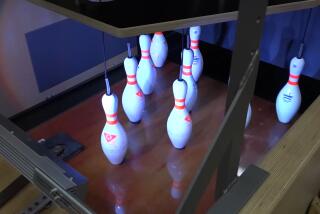Bouncing Around Air Circulation Ideas
- Share via
The next time you sit through a meeting in a room that is too hot, too cold, or so filled with stagnant air that you gasp for breath, think about Ping-Pong balls. Imagine the balls swooping around the room, riding currents of air or swirling around like whirlpools. The image might take your mind off of your discomfort. More importantly, it will give you a glimpse of its causes.
Researchers at the National Center for Supercomputing Applications (NCSA) at the University of Illinois at Urbana-Champaign are making Ping-Pong ball-like spheres bounce around a three-dimensional model of a conference room to diagnose air circulation problems and solve them.
The work is being done in conjunction with UTRC, the owner of Carrier Corp., one of the world’s largest manufacturers of commercial and residential heating, ventilating and cooling systems.
The Ping-Pong balls can be color-coded for temperature. They change from purple to red, for example, when the temperature rises. The researchers took the dimensions of a model conference room, the placement of vents and furniture, and created a computer simulation. The simulated balls, using equations drawn from fluid dynamics, represent air currents. This simulation, and the conclusions drawn from it, should help engineers and architects better plan where vents and furniture should be placed. It does nothing to silence the boring speaker, however.
*
Pumping Iron: Bodybuilders aren’t the only ones who get stronger when they pump iron. A researcher at the University of Dayton found that the glass fibers he developed to repair broken bones become stronger when fortified with iron oxide.
Unlike metal plates and pins used to fix large bone fractures, glass implants are absorbed by the body. This means that a patient would only need surgery once.
Since 1982, Binod Kumar, a senior research engineer at the University of Dayton Research Institute and a specialist in ceramics and glasses, has been looking for a glass that is not only compatible with the body, but also exhibits the desired strength and that dissolves slowly. The latter is important because glass loses strength if it dissolves too rapidly.
Kumar succeeded in producing a calcium phosphate glass that the body could absorb, but discovered the glass tended to dissolve quickly. Adding iron oxide produced a more durable glass fiber. But the technology still has hurdles to overcome before it can be used in hospitals.
*
Cleaning Up Chlorine: Everyone is familiar with chlorine, that gaseous chemical used to kill germs in water supplies and keep swimming pools algae-free. Less well known is the fact that millions of tons of chlorine are consumed annually in the reactions that create such everyday products as plastics, paints and packaging materials.
Most of the chlorine involved is incorporated into the products produced. But when waste chlorine combines with hydrogen it forms a corrosive and hazardous material--hydrogen chloride (HCI)--that dissolves in water to form hydrochloric acid. This is no minor problem: Chlorine is the eighth-most heavily used chemical in the world today, and while industrial uses exist for HCI, the supply far outweighs the demand.
Chemists have always known that it’s theoretically possible to convert the HCI waste back to hydrogen and chlorine using a copper compound as a catalyst. But existing processes have been inefficient and expensive because of the difficulties in handling the hot, corrosive mixture created by the reaction.
Now, USC researchers have developed a new process that avoids the corrosion and catalyst deterioration problems. Called the “catalytic carrier,” process, it involves a two-stage procedure in which HCI is reacted first with copper oxide, and the resulting copper chloride complex is transported to a second reactor, where it is oxidized back to copper oxide releasing chlorine gas.
They estimate that an installation using their process will recover chlorine from waste HCI at less than $80 a ton vs. the $250 a ton that “new” chlorine currently costs.





